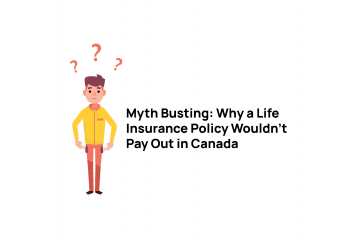One thing that comes up regularly when you work with people to set up a life insurance plan is working with them to figure out how much death benefit coverage they need. This comes down to the fundamental reason that people buy life insurance in the first place. They want to make sure that if something unexpected happens to them that their beneficiaries are looked after financially. Let’s take a second to look at how to figure out how much coverage you actually need, what it looks like if you’re over-insured, and finally, see if there are any situations where being over-insured makes sense.
In This Article:
- Why do you get Life Insurance
- Figuring out how much life insurance coverage you need
- What are the limits for Life Insurance
- When might you be okay with being over-insured
- Conclusion: How much is too much life insurance
Why do you get Life Insurance
People have a couple of reasons typically for getting life insurance. They have family members or business associates that would suffer financially if they were to pass away unexpectedly. By taking out life insurance, they can provide relief from that suffering. Having an insurance policy allows you to pay the premium knowing that if something happens to you, the death benefit will look after the beneficiaries.
Get a free quote
Figuring out how much life insurance coverage you need
In a nutshell, here’s how life insurance works. You are going to pay an insurer a premium, and if you die, they agree to pay your beneficiaries the death benefit amount for the policy. It is really a straightforward concept. The terms are pretty much black and white. If you’re alive, you pay the premiums; when you die, the death benefit pays out. How much your policy covers you is flexible and should be based on something that is called a needs analysis. What the needs analysis does is look at your situation today and figures out what you would have liked your beneficiaries to have received had you died yesterday. We cover this concept in a variety of articles, but it is important. We don’t guess where you’ll be financially in five years or ten years; we work as if you were gone now. The reason is that no one knows when they’re going to die, so if we plan based on assumptions for ten years in the future and something unexpected happens to you next week, your beneficiary could be in real trouble. With that in mind, let’s look at what a needs analysis should include:
- Do you own a home? Do you want to include paying off your mortgage as one of the goals should something happen to you?
- Do you have other debts aside from a mortgage that you would like to eliminate if something happened to you?
- What about your family situation? If you have kids, would you like to be able to supplement their education savings plans? Do you want to supplement family income? If yes, for how long?
- How long will each of these obligations last? You don’t necessarily need whole life insurance coverage to protect a mortgage. Consider what permanent items you want to cover and which ones are temporary and will go away in the future.
- What about savings that already exist that can help if you die? The key here is to not include things already earmarked for something else. For example, if the majority of your family’s savings are in RRSPs and RESPs, do you really expect that these will be chased in to supplement things after you die? You need to be realistic about this because assuming that a savings plan that is targeted somewhere else will be accessed when you die affects the goal that is in place for the other plan. No one likes the idea of having to work for 15 years longer than they had planned because they had to cash in an RRSP due to the unexpected death of their partner.
Working through these types of questions allows you to come up with the amount of coverage that you need. It often generates a pretty big number in reality, particularly if you have small children and a mortgage. The historically jaw-dropping factor of having a ‘million-dollar life insurance policy’ has disappeared as time has passed. These benefit amounts are far more common; having completed a needs analysis helps show the insurance company that you have put thought into what you need, and they are far less likely to question things when a needs analysis is shown.
What are the limits for Life Insurance
I used to talk to people all the time when planning a coverage amount, and life insurance policies sometimes get a bad rap. My personal favourite is how they are portrayed on Law & Order. How many times have you heard a detective on that show who is investigating a murder want to know if the victim recently purchased life insurance? Apparently, if you buy life insurance in TV land, you need to keep it a secret because if you tell someone about it, they may try and take you out to get the money. You should also know that being a life insurance beneficiary on TV makes you a suspect if someone finds an untimely demise. Once we get into the real world, we still see insurance companies wanting to avoid the situation where someone is worth more dead than alive. It’s not because they expect that your beneficiaries will murder you to get the money; it is because they are still companies looking to make sound financial decisions.
Typically, you will see limitations in place that aren’t necessarily hard and fast, but if you want to bypass them, you need to be prepared with a rock-solid reason that your need falls outside of the guidelines. A couple of examples could be trying to get an insurance policy where the death benefit exceeds 20 times your annual income. This multiple varies a bit based on how old you are and what insurance company you are working with, but in general, you need to have a reason for wanting coverage that exceeds that level of income multiple. This is where a sound needs analysis comes into play. As an example, it is completely possible that insuring the mortgage that you and your partner have undertaken results in an amount that exceeds the guidelines. Being able to explain how and why you need the coverage could get you an exception to the cap that allows you to have all the coverage you need in a single policy. Another example of limitations that has been encountered is the death benefit amount for a policy that you are placing on a child. Don’t get me wrong; I love the idea of a big life insurance policy for a child. This is the most cost-effective time for them to get coverage, and it is a legacy gift that you can pass on to future generations of your family. Just be prepared again for the question as to why the amount of death benefit is justified. I have seen the answer to this be based on the coverage that the parents have in place, so basically, don’t expect to get a kid’s policy for $500,000 in coverage if you own $20,000 on yourself.

When might you be okay with being over-insured
Often this comes into play with life insurance policies that a business owns. Policies owned by a business are a bit different; the business is the beneficiary of the plan that they own and will receive the money in the corporate account. The business then uses this money to deal with the fallout from the death of the employee or owner that was covered. This makes the needs analysis different. When you think of personally owned policies, we are often covering against debts and expenses that decrease as time passes (mortgage, education expenses etc.). This is why planning for today’s value is essential. Guessing where things will be in five years would result in a shortfall if you die before then. When looking at a business, though, the opposite should be true. If you have skills or talents that are essential to the business, the value associated with these goes up as time passes, and the same with the value of the shares in a business. Since the value increases, you need more coverage than what things are valued at today. Initially, having some extra coverage in place to help offset the growing future liability may be necessary. Typically, corporately owned life insurance policies fall into two main categories:
- Key-Person Insurance – This covers the business so that if a key employee passes away, they have the money to weather the short-term turmoil and recruit a suitable replacement for the key role that is now open. This is an employee who has skills and or intellectual ideas that are so important to your business that, if they were to pass away, your business would suffer financially.
- Buy-Sell Insurance – This is a policy that a business owns where the policy death benefit is used to pay the beneficiaries of a deceased partner’s estate for their ownership in a business. It is a share buy-back plan allowing the surviving shareholders to retain ownership of the company.
When looking at being over-insured as an idea, you can see how, when a business owns a policy on a key person or shareholder, the value that is needed today will not keep up in the future. The business needs to ensure that it receives the capital it needs to pay off the costs associated with the unexpected death, so it may make sense to apply for more than you need today to help make sure that you are looked after in the future.
Conclusion: How much is too much life insurance
One of my favourite things about working with life insurance is that it is a solution-based industry. I have yet to find a situation where someone who is healthy enough to have coverage can’t find a plan that fits their needs. What is essential is that you need to work with someone to figure out what those needs are. Completing the needs analysis allows your advisor the opportunity to show insurers that the requested death benefit on the policy is a well-thought-out amount and can be easily justified. You are not worth more dead than alive. What you are is someone who has put the effort into figuring out how much coverage you need to protect your beneficiaries. Life insurance companies are happy to work with healthy people who put that effort into their plans.




